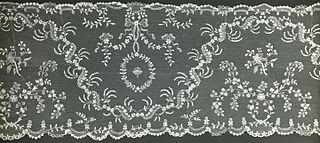
Argentan lace or Point d'Argentan is a needle lace from the 18th century. Argentella is derived from Argentan. Argentan lace exhibits a more prominent and larger pattern in contrast to its nearest variant, Point de Alencon lace. A distinctive feature of Argentan point lace is the "bride picotée", which may have originated from early Venetian lace-making techniques.
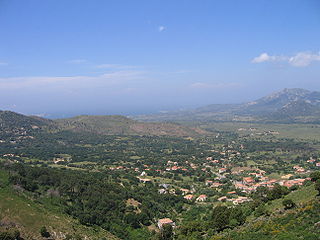
Calenzana is a commune in the Haute-Corse department of France on the island of Corsica.

The Coleophoridae are a family of small moths, belonging to the huge superfamily Gelechioidea. Collectively known as case-bearers, casebearing moths or case moths, this family is represented on all continents, but the majority are found in temperate areas of the Northern Hemisphere. They are most common in the Palearctic, and rare in sub-Saharan Africa, South America, and Australia; consequently, they probably originated in northern Eurasia. They are relatively common in houses, they seek out moist areas to rest and procreate.

Coleophora is a very large genus of moths of the family Coleophoridae. It contains some 1,350 described species. The genus is represented on all continents, but the majority are found in the Nearctic and Palaearctic regions. Many authors have tried splitting the genus into numerous smaller ones, but most of these have not become widely accepted.

Coleophora serratella is a moth of the family Coleophoridae. It is found in Europe, Japan (Hokkaido) and North America.

Coleophora limosipennella is a moth of the family Coleophoridae described by Philogène Auguste Joseph Duponchel in 1843. It is found in Europe from Fennoscandia to the Pyrenees, Italy and the Balkan Peninsula and from Great Britain to the Baltic States and Romania. It is an introduced species in North America.
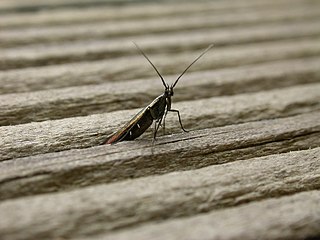
The clover case-bearer or small clover case-bearer is a moth of the family Coleophoridae. It is native to Asia, Europe and North Africa, and has been introduced to Australia and New Zealand.

The metallic coleophora moth is a moth of the family Coleophoridae. It is native to Europe and Armenia, but is an adventive species in the Nearctic realm, where it is found throughout the United States and southern Canada. It has also been recorded from New Zealand, Chile and Argentina.
Coleophora zelleriella is a moth of the family Coleophoridae. It is found from Sweden to the Mediterranean Sea and from France to southern Russia. It is not known from the Mediterranean islands.

Coleophora virgatella is a moth of the family Coleophoridae. It is found from Germany and Poland to the Pyrenees, Italy and Greece. It has also been recorded from southern Russia and central Asia.

Coleophora auricella is a moth of the family Coleophoridae. It is found from Germany and Poland to Spain, Italy and Romania. It has also been recorded from southern Russia.
Coleophora ballotella is a moth of the family Coleophoridae. It is found from Germany, Poland and the Baltic States to the Iberian Peninsula, Italy and Greece. It has also been recorded from northern and southern Russia.

Coleophora colutella is a moth of the family Coleophoridae. It is found in all of Europe, except Great Britain and Ireland. It is an introduced species in North America.
Argentella is a type of needle lace derived from Argentan lace, with a Rosacé ground, a "striking ground of tiny webs."
Argentella: A French needle lace made also at Abbisola in Italy. Developed from Argentan with Rosacé ground.
Argentella. A name given to a lace made in Genoa [Italy], but worked much like [the French] Point d'Alençon.
argentella lace[:] An early, white needlepoint lace made in Italy. Similar to the Alençon lace, but made with flat cordonnet. The patterns are delicate and spread over a net ground with small dots at the corners.
Argentella. ...a variant of point d'Alençon, which has a large mesh with a six-sided dot in the centre. This dotted réseau is known as fond de neige, and œil de perdrix, also as réseau rosaceé.
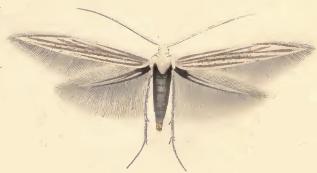
Coleophora millefolii is a moth of the family Coleophoridae. It is found in most of Europe, except Great Britain, Ireland and the Iberian Peninsula.
Coleophora oriolella is a moth of the family Coleophoridae. It is found in Germany and Poland to the Iberian Peninsula, Sardinia, Sicily and Greece and from France to southern Russia.
Coleophora dianthi is a moth of the family Coleophoridae. It is found in most of Europe, Russia, Turkey and Iraq.
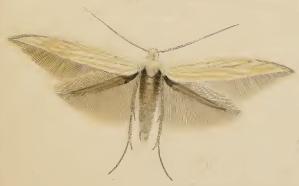
Coleophora silenella is a moth of the family Coleophoridae. It is found in most of Europe, except Fennoscandia, Ireland, Greece, Portugal and Ukraine.

The Lac de l'Argentella is a reservoir in the Haute-Corse department of Corsica, France. It was built in the 1870s to supply water to the ore processing plant of the Argentella mines, which refined silver and copper ore extracted from the nearby Capu di l'Argentella. After a few years the ore supply became uneconomical, and eventually the mines were closed in the 1930s. Recently there has been discussion on what to do with the aging dam. It stores water in a dry region, but may be unsafe.








